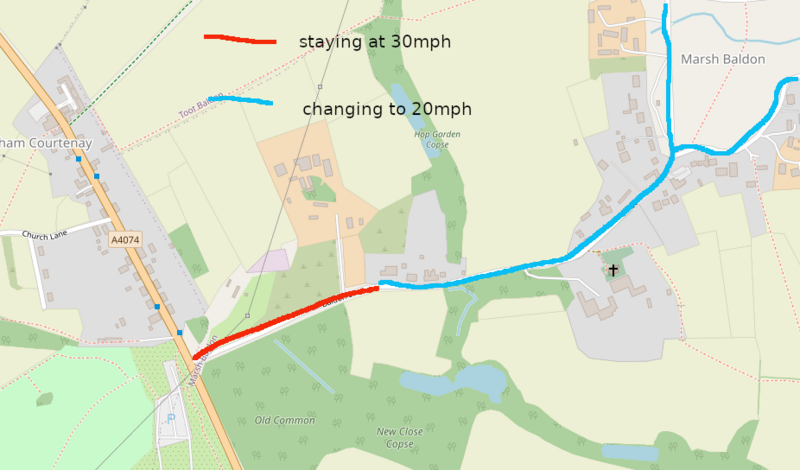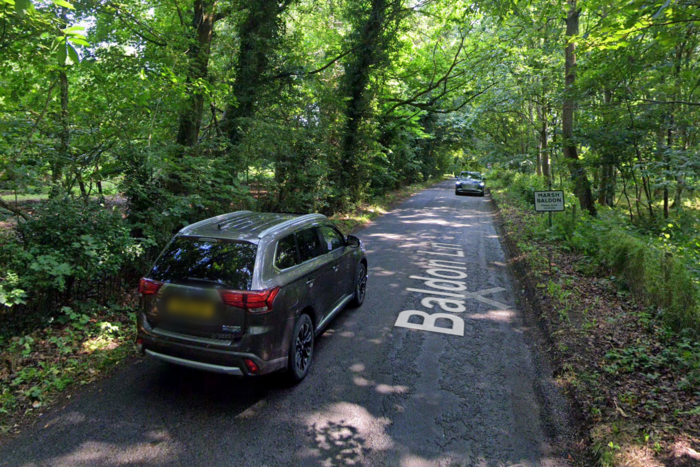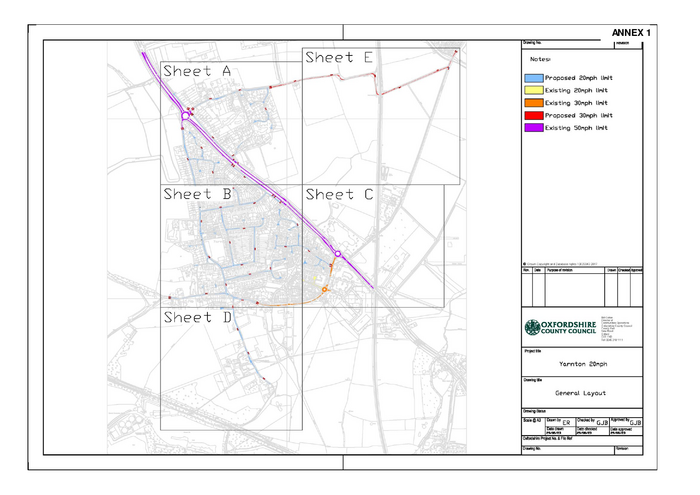The Oxfordshire policy on 20mph speed limits says that to be eligible an area must "be within the extent of the built-up environment of the town or village where vulnerable road users and vehicles mix in a frequent and planned manner" and "be in an environment that explains and justifies a lower speed limit to the driver".
A small addition to this would I think make sense. There are sections of road which are not within a built-up area, but which are key walking or cycling links. They may link a village to a bus stop or a strategic cycling route, for example, or an outlying housing cluster (hamlet) to a village centre, or a school to a town centre. Where such sections of road are relatively short and lower speeds would make a significant difference, perhaps because there are no footways or cycling infrastructure, or because crossings are necessary, I think they should be included in the scope of the 20mph policy.
Here are two examples, taken from the schemes decided on in the 14 December 2023 Highways delegated decisions meeting.

With the 20mph schemes in the Baldons, some residents wanted the 20mph area to include Baldon Lane, which connects Marsh Baldon with the A4074 and the bus stops at Nuneham Courtenay. One wrote:
"Baldon Lane is the most hazardous part of the Baldons from a traffic point of view and I would support a 20mph limit along there. Many pedestrians use this road as there is no pavement, including with buggies, on the way to and from the bus in Nuneham Courtenay. It is sometimes hard to see them in the dark. Additionally, the bend by the Seven Stars is hazardous because oncoming traffic is not visible until it is almost upon you. Parked cars along Baldons Lane, pushing cars onto the wrong side of the road, increase the hazard. 20mph would reduce the hazard. Finally, the Baldons is supposed to be access only; a 20mph limit throughout would support this and deter motorists from using it as a through route (which they currently do)."
This 300 metre stretch of Baldon Lane is clearly not within the built-up area, but is also clearly important as a walking route. There are no reported collisions on this stretch, but it is plausibly hostile enough, lacking any footways or even an accessible verge, to deter some people from walking on it at all, or letting their children walk along it, and lower vehicle speeds would help with that.
Using 20mph limits to improve access to bus stops may also help to offset bus operator concerns about lower speed limits increasing bus times. In this case, buses losing some time through Nuneham Courtenay might be offset by increased patronage from residents of Marsh Baldon.
Similarly, in the Yarnton 20mph scheme the Cassington Rd along the south-eastern edge of the village (orange in the map above) has been left at 30mph, despite a forceful request from the Parish Council that it be included in the 20mph area:
"There is a stretch of the Cassington Road, between the Pixey Close junction and the Turnpike roundabout on the A44, that is within the current 30 mph zone, but is not included in the new 20mph zone. This must be included. It is in part a very busy section of road and in part the most dangerous piece of road in the village. ... Given the speed bumps, the traffic, the roundabout, the bus-stops and the lack of pavements or verges, there seems every reason to include these stretches of road within the 20mph zone. Yarnton Parish Council recommends this most strongly."
Not only do people from Yarnton need to cross Cassington Rd to access the westbound bus stop, but for many residents of Yarnton this stretch of road — currently without any cycling infrastructure at all — is part of their cycling connection to the cycle track on the A44.
Judging from the responses by officers at the delegated decisions meeting, there is a recognition that such sections of road could be included in 20mph schemes, but it would be good to make that explicit. My suggestion is that the first clause of the policy be augmented with something like:
"or are short stretches of road which connect the town or village to public transport, active travel routes or important destinations, where lower speed limits would ameliorate a hostile or unpleasant walking or cycling environment"
More broadly, the goals of the 20mph transformation programme should explicitly include improving route accessibility alongside reducing road danger. 20mph changes should also be coordinated with other schemes that overlap or abut them geographically, such as corridor improvements, the Strategic Active Travel Network and Greenways routes, and School Streets schemes.


